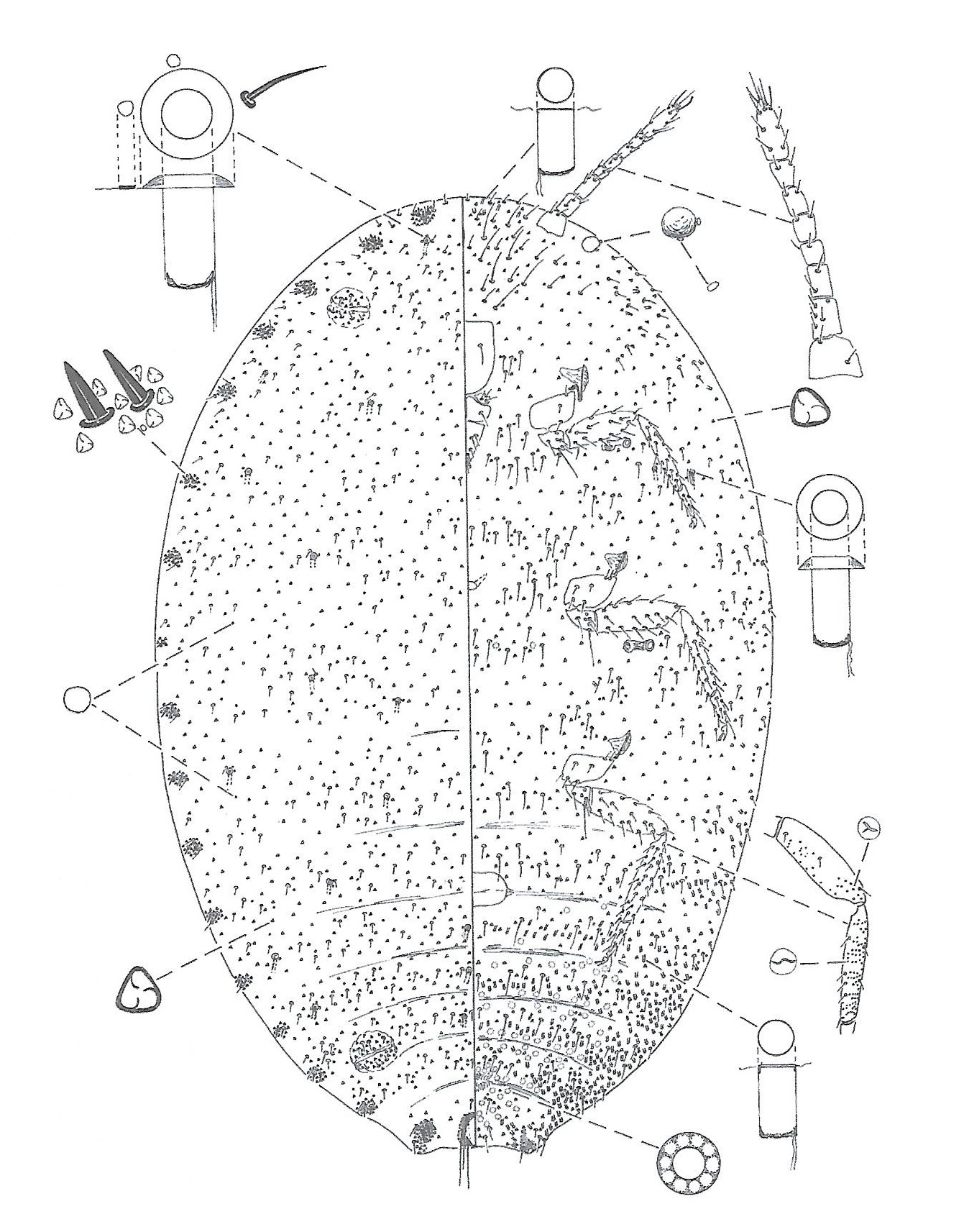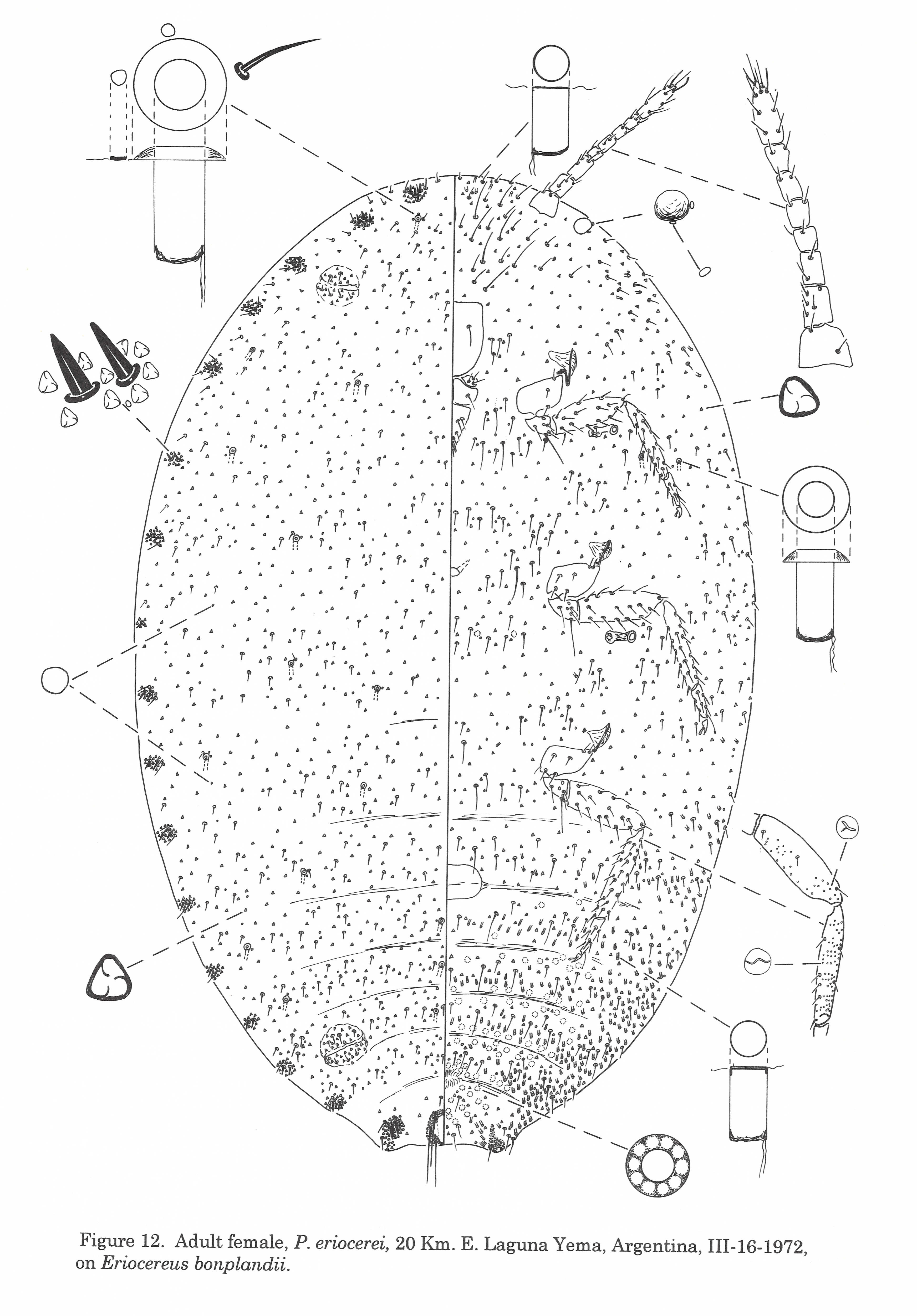Valid Names Results
Pseudococcus eriocerei Williams, 1973 (Pseudococcidae: Pseudococcus)Nomenclatural History
- Pseudococcus eriocerei Williams 1973a: 569. Type data: ARGENTINA: Formosa State, on roots of "Eriocereus bonplandii". Holotype, female, Type depository: London: The Natural History Museum, England, UK; accepted valid name Illustr.
Common Names
- Eriocereus mealybug GimpelMi1996
- eriocereus mealybug MillerGi1996
Ecological Associates
Hosts:
Families: 2 | Genera: 3
- Cactaceae
- Cleistocactus | GimpelMi1996
- Cleistocactus baumannii | GranarGo2018
- Harrisia bonplandii | GranarGo2018 | (= Eriocereus bonplandii)
- Zingiberaceae
- Zingiber officinale | GimpelMi1996
Geographic Distribution
Countries: 1
- Argentina | BenDov1994 GimpelMi1996 Willia1973a
Keys
- GranarGo2018: pp.10-14 ( Adult (F) ) [Central & South American Pseudococcus]
- VonEllWa2016: pp.74-75 ( Adult (F) ) [Pseudococcus species present in the New World]
- WilliaGr1992: pp.427 ( Adult (F) ) [Central and South America]
Remarks
- Systematics: Pseudococcus eriocerei is similar to P. viburni but differs by having: 66(42-84) trilocular pores on venter of segment VI; 2(1-4) ventral oral-collar tubular ducts mesad of cerarius 12; 2(0-5) ventral oral collars associated with cerarii 10 and 11; 2(1-3) cisvulvar setae; longest interantennal seta 77(40-99)µ long; antennae 411(341-452)µ long; cerarius 12 with 1 (0-3) auxiliary setae and 10(5-15) trilocular pores; 19(0-42) translucent pores on hind femur; tarsus 93(79-104)µ long; longest seta on hind trochanter 99(82-114)µ long. Pseudococcus viburni has: 154(132-200) trilocular pores on the venter of segment VI; 10(8-16) ventral oral collars mesad of cerarius 12; 1(0-2) oral collars associated with cerarii 10 and 11; 4(3-5) cisvulvar setae; longest interantennal seta 102(73-134)µ long; antennae 509(456-585)µ long; cerarius 12 with 3(2-4) auxiliary setae and 19(15-23) trilocular pores; 65(15-150) translucent pores on the hind femur; tarsus 122(114-142)µ long; longest seta on hind trochanter 144(108-157)µ.long. (Gimpel & Miller, 1996)
- Structure: With 19(0-42) translucent pores on hind femur; 2(1-4) oral-collar tubular ducts mesad of cerarius 12; 2(0-5) oral collars associated with cerarii 10 and 11; 1(0-3) auxiliary setae and 10(5-15) trilocular pores in cerarius 12; antennae 411(341-452)µ long; femur 239(217-267)µ long. (Gimpel & Miller, 1996)
- Biology: Williams & Granara de Willink (1992) suggested that it appears to be confined to cacti of the Cereeae group. Occurring on the roots of the host plant.
- General Remarks: Good description and illustration of the adult female given by Williams & Granara de Willink (1992) and by Gimpel & Miller (1996).
Illustrations
Citations
- BenDov1994: 390
- CaballPaKa2021: morphology, 8
- GimpelMi1996: description, distribution, host, illustration, taxonomy, 53-56
- GranarGo2018: diagnosis, distribution, host, illustration, key, taxonomy, 5-14, 28-29
- VonEllWa2016: key, 75
- Willia1973a: description, distribution, host, illustration, taxonomy, 568-570
- WilliaGr1992: description, distribution, host, illustration, taxonomy, 443, 444




